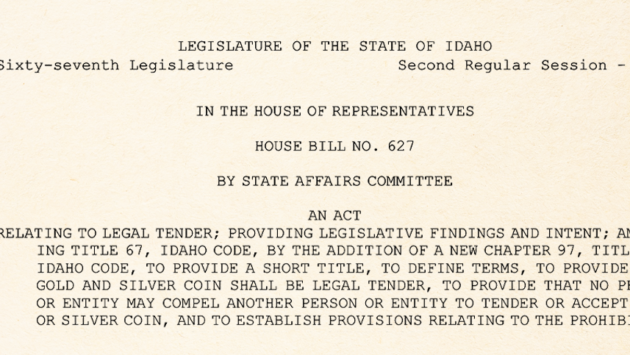
It should come as no surprise that precious metals make up a very high ratio of my personal savings, and I believe wholeheartedly in their benefits. After all, I co-founded Gold Alliance, and I’m its CEO. If I didn’t believe in the virtues of gold, silver, and other precious metals, I wouldn’t want my job.
With their numerous benefits, physical precious metals are remarkable assets, a way to secure the purchasing power of my family’s financial future. I’ve lived through a few financial crises, and I’ve witnessed how easily fortunes come and go. I have also seen how diversifying with precious metals has saved and even grown fortunes. They are a vehicle of protection and growth.
When Ray Dalio, legendary investor and the founder of the world’s largest hedge fund, was asked why he recommended his hedge fund’s clients acquire gold, he responded:
“If you don’t own gold, you know neither history nor economics.”
I use this statement on my personal signature page. It’s profound to me as it’s my mission to educate Americans and explain the importance of owning a portion of their savings in precious metals to seek financial security and even freedom, in some cases.
Below, I’d like to explain what stands behind Ray Dalio’s statement by showing you why I own gold.
Gold is there in times of crises
Gold is generally known as a hedge against market crises like recessions. History is on the side of this claim.
Let’s look at recessions and inflation over the past 50 years to see the strength of owning gold. The chart below shows the price of gold (yellow line), the inflation rate (red line), and recessions (gray areas).
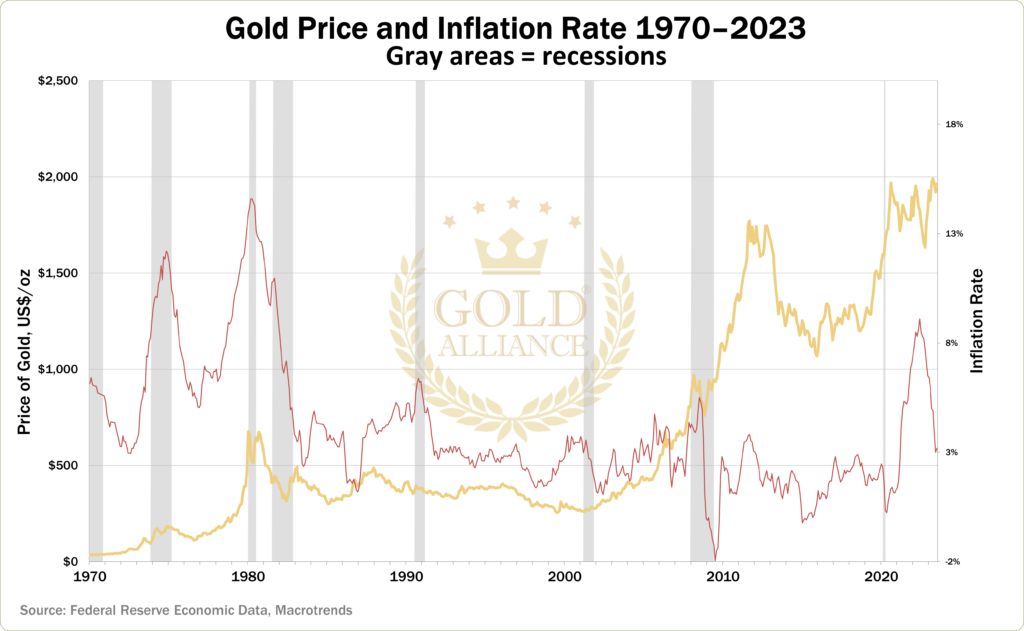
During or following most of the recessions in the past 5 decades, gold saw significant growth. Likewise, while inflation hollowed out the purchasing power of the dollar, the value of gold grew. In simpler terms. If you think you will see a recession or inflation in your lifetime, it’s important to note that gold has historically been a way to mitigate those risks. And I can’t show a chart like this without pointing out just how stunningly well gold has performed — just look at the performance of the last 20 years!
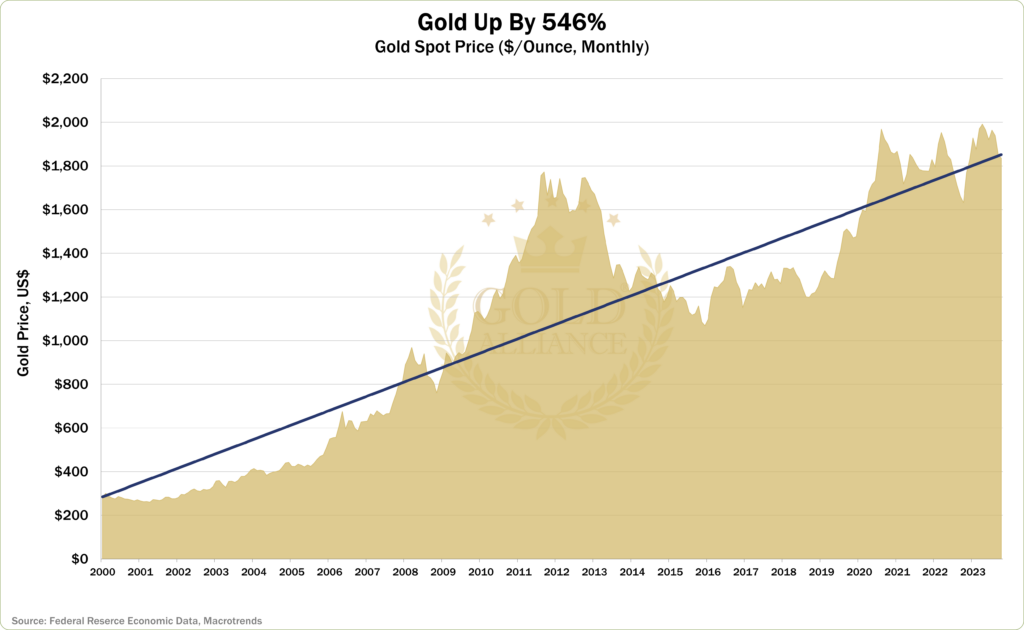
Gold may help protect your purchasing power from inflation – the 1970s example
The inflation crisis of the 1970s is the absolute best example of how gold may help you protect your purchasing power against inflation. After we gave up the Gold Standard in the early 1970s, the purchasing power of the dollar fell rapidly. Meanwhile, throughout the 1970s and into the early 1980s, the price of gold skyrocketed.
Anyone who had a stake in gold during that time not only enjoyed the protection of owning the precious metal but also saw their wealth grow. Anyone who didn’t own gold at that time saw the purchasing power of their savings dwindle and the value of their paper assets and real estate plummet.
This is one of the biggest reasons I own gold. Because I know how gold historically outperformed all other assets during past inflationary periods:
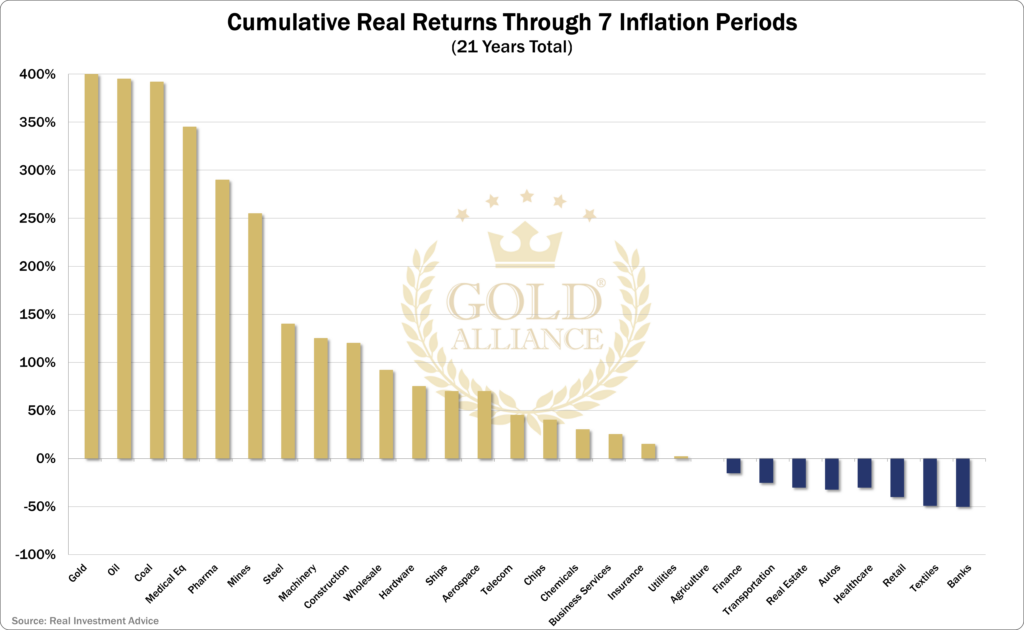
How gold is uncorrelated with paper assets
Again, gold’s historic performance points the way:
When the dot-com bubble burst in early 2000, the stock market began a downward spiral that lasted until 2003.
For those who had most of their investments in paper assets, the outlook wasn’t good. But during the same three years, the price of gold was on the rise, and those who had held some gold during this time didn’t feel the sting nearly as bad as those who did not. Some even came out on top.
Why do I own gold? Because its fate is not joined by the hip to my paper asset portfolio.
How gold is uncorrelated to real estate and the markets — the 2008 example
The year 2008 is an excellent example of why it makes sense to diversify with more than one asset class. Many assets are correlated to paper assets and go down when paper assets go down, even assets you would never imagine that are correlated this way, so it is just logical and wise to include an asset like gold that is uncorrelated to the markets to hedge your risks.
Hedging market investments with property and real estate investments did not save those who did it from the financial crisis of 2008. Quite the opposite: They led the crash. And some real estate investors who had diversified with paper assets were not protected because everything they had crashed at the same time…
Everything crashed and stayed down for quite a few years … except gold. From 2008 to 2011, the price of gold nearly tripled while the value of the stock market slowly limped back from the collapse.
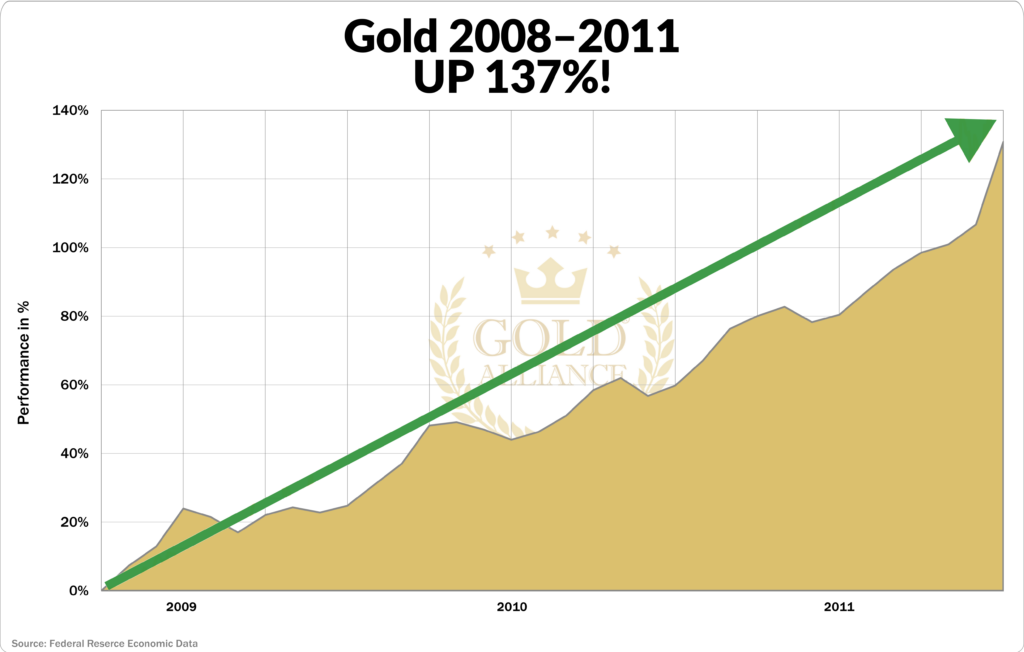
So by 2011, only three years after the crash, the gold portion of the portfolio had offset any losses — regardless of the portfolio’s asset mix — and even offered growth to a portfolio that was heavy in paper assets and real estate.
The 2008 crisis example also led us — as a company responsible to our clients — to come up with our internal compass for how much gold a person may choose to hold. At that time, anyone who had a 30% stake in gold in 2008 didn’t suffer the financial blow that other investors did. On the contrary, they grew their wealth. Acquiring a single gold coin may not protect a $50,000 portfolio, but so far, we have not seen any reason to own more than 30% of anyone’s savings in gold to offer ample protection.
You don’t need to go all in with gold to protect your portfolio
If you want to, it’s imperative that you prepare for any possible market crash/real estate crash/bond crash/dollar crash/war. Although we can’t predict when it will happen, what will trigger it, or how badly it will affect the economy and various asset classes, history has proven that there will always be another crisis — even when the Fed, the Treasury Secretary, or financial experts claim, “this time is different.” Overvalued markets always go through a correction.
While I’m an advocate for acquiring gold, I also advocate to not go over 30% in gold or in any asset class. Getting too aggressive with your allocation into gold puts you in the same position as getting aggressive with any other asset class. Wall Street and the paid financial media promote the idea that a good, solid, and risk-free portfolio could be made up of 100% in paper assets. That illusion cracked in 2008, and the only reason it is still out there is the massive stimulus and money printing re-vitalized the market in the span of seven years to where it was before.
Investors lost the inflation that occurred during these years, but by 2015 they were seeing the same value again in their portfolio, so they kept on going with a mantra that “markets will always rebound.”
While that may become true eventually, waiting for it to rebound during an inflationary period is like waiting to never have your portfolio regain its purchasing power. $100,000 today will not buy you what it did 10 years ago. And do you believe it will buy you what it buys today 10 years from now?

Or call 888-529-0399 to schedule a free consultation with an experienced Gold Specialist. There’s no obligation.



